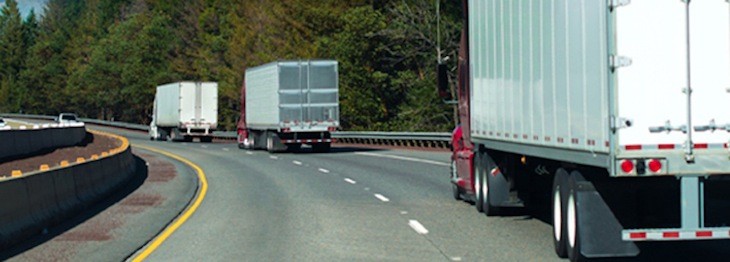Big rig sales jump 43%, trailer orders up 32% in December
by January 24, 2018 2:34 pm 332 views

U.S. class 8 truck sales rose 32% to 45,700 units in December, and U.S. trailer orders increased 30% to 45,200 units as carriers purchased trailers to accommodate for tightening capacity in light of the ELD mandate and a persistent driver shortage.
But the December rise in sales of class 8 trucks, the largest truck class, wasn’t enough to push total sales for 2017 ahead of the 2016 total, according to WardsAuto.com. In 2017, sales fell 0.2% to 192,252.
In December, Freightliner, a brand of Daimler Trucks North America, nearly doubled its volume, capturing 38% of market share. Volvo was the only truck manufacturer to underperform, with sales down 12.8%. Sister brand Mack increased sales by 5.8%. Overall, Volvo Truck sales fell 4.5% in December, according to WardsAuto. December sales volume was the highest since July 2015, when the total was 23,383.
Also in December, trailer orders reached the second best order volume in history, behind the all-time record of more than 47,000 units set in October 2014, said Frank Maly, director of commercial vehicle transportation analysis and research for ACT Research.
“Contributing last month were solid performances for both dry vans and reefers. The stay of GHG-2 regulations helped move fleets into the market last month, and continued demand for freight transport and solid freight rates contributed to their ongoing confidence. Lengthening OEM backlogs also helped encourage fleets onto the order board.”
Carriers are purchasing thousands of dry-van trailers to meet demand as they resort to more drop-and-hook shipments to accommodate for the driver shortage, according to Transport Topics, a publication of American Trucking Associations. These type of shipments allow drivers to drop off a trailer and get another without having to wait for the trailers to be unloaded or loaded.
For 2017, the number of trailers ordered increased 38% to more than 313,000 units, from 2016, according to ACT Research. It was the third highest order year in history, trailing only 2014 and 2015.
Across North America, Class 8 truck sales increased 75% to 37,500 units in December, the highest monthly order total in three years, said Michael Baudendistel, transportation equipment analyst for Stifel. The rise was in line with expectations as December orders were expected to be higher than October orders of 36,100 units.
“The U.S. market was the primary driver of December’s Class 8 order strength, with orders climbing 127% (year-over-year), even as cancellations remained negligible,” said Kenny Vieth, president and senior analyst. Orders of tractors with sleeper berths increased 260%, from the same month last year. “The inability of carriers to find drivers, the inflection in freight volumes, hurricanes and the strongest holiday shopping season since 2010 have conspired to create a capacity shortfall that has destabilized the trucking industry’s supply/demand balance.”
The strong orders since September have led to a rise in Class 8 backlogs and should lead to increased Class 8 production in 2018, Vieth said.
2018-2019 OUTLOOK
In a research brief on truck dealer Rush Enterprises, transportation analyst Brad Delco of Stephens Inc. expects fourth-quarter earnings to be higher than the consensus of analysts as sales have been better than expected.
Also, Delco updated the New Braunfels, Texas-based company’s earnings per share estimates to $3.20, from $2.65, for 2018 and to $3.45, from $2.95, for 2019 as a result of ACT’s recently updated truck forecast and because of a projected lower tax rate of 26%. However, Delco reduced its 2017 earnings per share estimate by 1 cent to $2.19 because the company paid $6.6 million in employee bonuses to its 6,600 employees as a result of the tax reform.
“We believe fundaments are strong for (Rush) and are getting more constructive on the stock given the recent pick up in energy related activity,” Delco said.
In the fourth quarter of 2017, Rush’s sales of Class 8 trucks are expected to rise 52% to 3,800 units, or a nearly 6.5% market share of Class 8 truck sales. In 2018, Rush’s sales of Class 8 trucks are expected to increase 26.5%, based on the improvement of sales across the industry.
“We continue to believe there is more upside than downside to our 2018 Class 8 production estimate of 305,000 units,” Baudendistel said. “We believe, as well, that 2018 will not represent the ‘peak’ this cycle, which has become a concern among investors, as we believe 2019 will be stronger yet, supported by increasing replacement demand, improving freight fundamentals (especially pricing), and the cash benefit to fleets and other truck buyers of lower corporate tax rates and increased bonus depreciation.”
The fall order season, which runs from October to December, represents the start of orders for trucks that will be delivered in the following year. In the 2017 order season, orders increased 94%, from the 2016 order season. In 2018, orders are expected to rise 19%, and 2019 is expected to be an even stronger year, as fleets that purchased a large number of trucks in 2014-2015 return to the market to trade in those trucks, Baudendistel said.
“ELD implementation is now in full swing and will continue through the initial enforcement phase of April 1 of this year,” said Jonathan Starks, chief operating officer for research firm FTR. “This is contributing to the tight capacity environment and is combining with strong freight activity to move freight rates higher. Our forecast continues to call for an increase in production for 2018, but market expectations are varied for 2019.”
